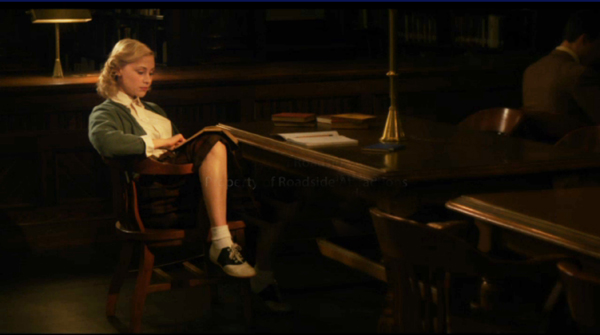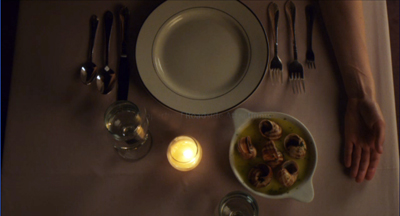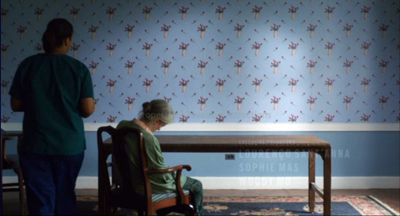INDIGNATION: Novel into film, novelistic film
Sunday | August 7, 2016 open printable version
open printable version
Indignation (2016).
DB here:
As I finish my book on 1940s Hollywood storytelling, I see that period’s influence all over the place. (Actually, that’s part of the book’s point.) One thing that filmmakers did back then, I think, is make cinema more “novelistic.” It’s not just that they took stories from novels, though they certainly did. They also made much greater use of storytelling devices that had become common in literature both high and low.
Many of these techniques I’ve talked about in other entries. There were, of course, flashbacks—not new to the Forties, but now much more frequent than in the Thirties. There was also the rise of voice-over commentary, like the narrating voice of fiction. It might be the voice of an objective narrator, as in Naked City (1947). Or it might be the voice of a character, either telling the tale to another character, or recalling events purely in his or her mind.
Other types of subjectivity came forward too, such as dreams, daydreams, and hallucinations. Filmmakers of the 1930s were inclined to tell their stories objectively, through concrete behavior. But thanks to imported and revised literary strategies, many Forties films gain a greater density and interiority. Compare, for example, the 1931 Waterloo Bridge with the 1940 one.
One thesis of my book is that filmmakers of the Forties consolidated these strategies in a way that became central to modern movie storytelling. That seemed to me to be confirmed when I saw James Schamus’s directorial debut, Indignation, now or soon playing at a theatre near you. Because of his skill as a screenwriter, I expected an intelligent adaptation of Philip Roth’s novel, but I also hoped to learn more about the expressive resources of contemporary cinema. I wasn’t disappointed.
Indignation’s core story involves Marcus Messner, studious son of a New Jersey butcher who goes off to a Midwestern college. Stuffed with ideas and ambitions, Marcus is intellectually worldly but socially and sexually naïve. If he weren’t in college, he’d be drafted to fight in the Korean War. Instead of fitting smoothly into academic life, he finds himself confused by Olivia Hutton’s calculated sexuality. In addition he struggles with an overprotective father and the puritanical, hamfistedly Christian, regimen of 1951 campus life.
To talk about what I find exciting and instructive in the film, I have to presume you’ve seen it. So what follows is filled with spoilers.
Sticking to one causal line
Like the book, the film is an exercise in restricted point of view. That involves not simply the voice-over commentary that weaves in and out. (In a film, that technique doesn’t guarantee restriction the way first-person narration would in a novel. Movies can be more promiscuous in breaking with what one character thinks and knows.) And the restriction isn’t wholly a matter of a subjective plunge either, though we do get Marcus’s dreams and fantasies and some fragmentary flashbacks.
No, what makes Indignation intriguingly “novelistic” is a matter of attachment. We’re simply with Marcus through almost the entirety of the movie. We know only as much as he knows. This means that we learn about certain things when he does. His father’s breakdown back home is conveyed through phone calls. At the climax, his mother’s visit to him in the hospital reveals that she’s considering divorce. An alternative narrative strategy would be to shift from scenes with Marcus to scenes elsewhere, say back home in New Jersey or in Olivia’s dorm. This “omniscient” option is more common throughout American film history; we see it in the crosscutting between CIA malefactors and poor David Webb in Jason Bourne.
Restricted narration isn’t the only way to generate mystery, but it’s a reliable one. By attaching us to Marcus’ range of knowledge, Indignation creates mysteries, chiefly around Olivia. What has made her behave as she does? She never offers a full explanation, but in some scenes she tells more about her parents and in a crucial confession she confesses her alcoholism, a suicide attempt, and a period in treatment.
During this confession, Schamus finesses the showing/ telling problem in an intriguing way. There are good reasons, I’ve suggested before, to let such monologues play out in the space and time of the scene. Telling is sometimes more vivid than showing. But Schamus has chosen to show as well as tell, by providing quick flashback illustrations of what Olivia recounts to Marcus.
What interests me is that these images from the past have an in-between status. They’re neither straightforward and neutral, nor Olivia’s own viewpoint, nor exactly Marcus’s imagined version of what she’s telling him. For instance, the straight-down, somewhat diagrammatic and clinical framing of some of them calls to mind the film’s first shot, also associated with Olivia’s health: the pill case in the care facility.
Likewise, the shot of Olivia in a straitjacket, framed off-center in a way few other isolated long shots in the film are, has an abstract quality that suggests an image lying somewhere between her memory and Marcus’s imagining of her situation—without making it wholly subjective. (In the early 1950s, it’s plausible she was indeed treated this way.)
At the climax, we get even less information about Olivia’s situation. Before Marcus can break off with her, she simply vanishes. Marcus will never find out what became of her. For him, if not for us, the mystery is permanent.
Not that he doesn’t try to communicate. This is one role of the voice-over in which he muses on his past and, more ambitiously, on the role of cause and effect in life. As a follower of Bertrand Russell, he’s evidently pondering Russell’s idea of “causal lines.” Ironically, though, Russell’s inferential model of causality doesn’t help Marcus figure out what happened to Olivia.
But from where is Marcus speaking? Quite likely, from the Afterlife.
Dead narrators drift through 1940s cinema. Philip Roth was ten when The Human Comedy (1943) featured a deceased father returning to his small-town family, and eleven when The Seventh Cross (1944) gave us an executed prison-camp escapee who shadows one of his mates. So Indignation, set in the year after Sunset Boulevard (1950), seems perfectly in keeping with this trend. But these other films announce the voice-over’s posthumous status right away. Schamus does something a bit different.
In the source novel, Roth lets Marcus suggest that he’s dead about a quarter of the way through. Schamus’s screenplay drops hints that are, I think, fully noticeable only in retrospect. He creates a surprise that in turn motivates one of the two frames that surround the 1951 story action.
The front end of the inner frame is a brief combat skirmish in South Korea. A GI is pursued into a dark, nondescript building by a North Korean soldier. The action is difficult to discern, but we can see that the Korean is shot. Did the GI escape? The combat scene will be partially replayed near the film’s end, closing the frame the first one opened. The GI will be revealed as Marcus, who is dying from a bayonet thrust.
This isn’t merely a trick. In the 1940s filmmakers realized that some stories, if told chronologically, begin in rather slow and uninvolving fashion. But starting at a crisis late in the story’s causal chain, and then flashing back to what led up to it, can arrest our attention. Think of what The Big Clock (1948) would be like if we started not with the hero dodging around corridors trying to elude the police, but with his mundane office routine earlier that morning. So instead of starting with Greenberg’s funeral, Indignation grabs us with a brief and enigmatic piece of life-or-death action.
1940s frames are more explicit about the framing situation than the combat incident in Indignation. Yet Schamus evidently didn’t want to show Marcus lying there dying and reflecting on his life and leading into the film as a whole: too on-the-nose, and perhaps too obviously fatalistic. The shift to the Jonah Greenberg funeral frees the story action from what Henry James once called “weak specificity.”
There’s also the possibility that Marcus survives; we don’t see him die, even in the finale of the skirmish. The fact that the film can equivocate about whether our narrator is alive or dead emerges as a fresh treatment of the Afterlifer convention.
By raising the possibility of a dead narrator early on, Roth may make us view Marcus’s actions with more detachment, sub specie aeternitatis. The film version, I think, gets us more emotionally invested in Marcus, and this makes the eventual possibility (for me, the likelihood) that he has died more wrenching.
More than Marcus
Even in the enframed 1951 story action, our attachment to Marcus’s range of knowledge isn’t complete. For one thing, there are ellipses—most notably, the crucial scene in which he asks Olivia on their first date. There are also moments in which we run ahead of his awareness. When his mother meets Olivia, Schamus has controlled his actors’ eyelines so that even in a two-shot we’re not looking at the hero but rather at Mrs. Messner, who spots the girl’s wrist scar.
This is sharp visual storytelling. Marcus is unaware of his mother’s observation, but we’re prepared for her later admonition that he’s getting involved with a woman who will bring him misery. (Marcus: “She slit one wrist.” Mrs. M.: “One is enough. We have only two, and one is too much.”)
We’re also a beat ahead of Marcus in one neat shot that shows him stepping onto the quad as he’s facing expulsion. We see his future before he does; the marching ROTC students in the background catch our notice before a rack-focus brings him up to speed.
We’re also invited to see parallels that pry us a bit away from Marcus’s immediate experience. At two crucial moments, the adults trying to intimidate him—Dean Caudwell and his mother—come around behind him to keep wheedling.
The know-it-all debater has a chance when fighting face to face, but he crumbles when authority steers from behind.
Above all, our attachment to Marcus is qualified by a second frame, the one that wraps the whole fiction. This is wholly Schamus’s invention—a nested structure of the sort characteristic of 1940s films. At the very beginning and end of Indignation, we see an elderly Olivia in a care facility staring at the wallpaper dotted with a pattern of flowers in a water carafe. The image (also on a skirt she wears in the college portion) harks back to her impromptu bouquet for Marcus in the hospital.
But of course we’re inclined to ask: How likely is it that such a pattern would be used on wallpaper, and would it so neatly coincide with an item in Olivia’s past? We could then ask whether the pattern is in her imagination. (There is a sort of blurring and refocusing on the pattern, suggesting her optical viewpoint.) And since her scenes in the facility bookend the entire film—the Korean War frame, which in turn encloses the Winesburg College days—we might ask whether everything we’ve seen isn’t a product of her fantasy.
I’m not inclined to say that she has made up the whole movie. Indeed, if the wallpaper pattern is her projection, it would have to be so not just in her optical POV but also in the wider shot of her, the first image we get of her as an old woman.
Maybe this room, Caligari-like, is a total projection of her memory? More likely, it’s objectively there but triggers her recollection of Marcus. I’m still uncertain, but it does seem that giving Olivia the ultimate framing for the tale via their shared moment with the flowers suggests that Marcus, who at the end of his last monologue is calling out to her, has somehow finally made contact.
In any event, a purely formal cadence, completing the ABCBA structure and revisiting an ambivalent motif in the film, can balance, in aesthetic terms, the absence of answers to questions posed in the story world. This appeal to geometrical architecture and symmetrical construction is, since Henry James, another novelistic convention: art’s order can frame, if not completely account for, the disorder of life as it’s lived.
Goliath wins
The sequence that has everybody talking is the sixteen-minute two-hander between Marcus and Dean Caudwell. It’s in the book, but Schamus and his players have brought to life the clash between idealism and suave, well-practiced bullying.
Straddling the film’s midpoint, this scene enacts the old proverb. “Old age and treachery trumps youth and skill.” It starts with a simple bureaucratic issue: Marcus’s transfer out of the dorm to a shabby, solitary room. This incident leads Dean Caudwell to charge him with stubbornness, lack of compromise, secrecy about his Jewish identity, friction with his family, intellectual arrogance, and cowardice. The whole cascade is punctuated by the Dean’s intermittent requests to stop calling him “sir.” It’s a verbal boxing match with Marcus gamely fighting on after quite a few low blows. Nobody who read Why I Am Not a Christian in their youth (as I did) can fail to be roused to self-righteous fury by Caudwell’s calm, close-minded innuendo.
Still, in such duels dialogue and performance need to be orchestrated with framing and cutting. Steve McQueen’s solution in Hunger (2008) is the use of a sixteen-minute profile long-shot, followed by a cut in to Bobby Sands’ hand picking up his cigarettes, and then a very tight close-up of his face as he continues speaking.
The interruption of the long take gives special prominence to a shift in the conversation, when Sands recalls his childhood. Later shots revert to shorter shot/ reverse-shot exchanges.
So framing and cutting can articulate phases of the drama. This Schamus does very carefully in the Indignation scene. To abbreviate:
Phase 1: More or less businesslike and polite: Why couldn’t Marcus compromise with his roommate? 180-degree cuts, with framing favoring Dean Caudwell–centered and dominating Marcus.
Phase 2: Caudwell gets personal. Why didn’t Marcus identify his father as a kosher butcher? Eventually he’ll accuse Marcus of intolerance. Here a fairly lengthy profile shot reminiscent of Hunger gives way to shot/ reverse-shot.
Phase 3: More personal probing: How does Marcus get along with his family? What about his sex life? And religion? After more shot/reverse shot, Marcus, sweating and feeling sick, rises to defend himself in close-up. That calls forth the closest shot yet of Caudwell.
Phase 5: Caudwell says Marcus’ sophistry will make him a fine lawyer. He comes to stand behind Marcus, putting his hands on his shoulders. Then he sits beside him, to drill in still more. Marcus, shaky, asks to leave.
Phase 6: At the door: Marcus is feeling sick. The dean asks if he’d like to play baseball. Finally Markus collapses and starts vomiting.
Schamus has saved shot/ reverse shot for when the scene heats up, and saved his close-ups for when things reach a pitch. This reminds us, as the Hunger scene does, that if you’re going to use a standard technique, hold off until it will do the most good. Ditto for the low angle on Marcus throwing up; that comes with more force if we haven’t already had low angles before. Schamus has let his cutting and shot scales amp up the drama without the crushing emphasis supplied by so many directors. Yes, I’m thinking of the barrage of close-ups in every dialogue scene of Jason Bourne. (Thanks to Paul Greengrass, Tommy Lee Jones’s facial contours qualify for Federal Drought Relief funds.)
I think that Indignation will be studied for years as an intelligent adaptation of Roth’s novel, but it ought also to be admired as a well-crafted work in its own right. It finds fresh ways of molding fiction techniques to the demands of cinema in general and Hollywood tradition in particular. And the film reminds us—or me, at least—how much contemporary filmmaking owes to the consolidation of “novelistic cinema” seventy years ago.
Thanks to James Schamus, Gustavo Rosa, and Lauren Hynnek for information and assistance, . For more on James’s career, see our entry.
Students of literature might find another novelistic analogy in Olivia’s explanation of her suicide attempt. It somewhat resembles the technique of free indirect discourse, when the third-person authorial voice adopts the language and syntax of the character’s thought. Roth employs this in the third-person tailpiece of his novel. Instead of “If only I hadn’t let Cottler hire Ziegler to proxy for me at chapel!” we get “If only he hadn’t let Cottler hire Ziegler to proxy for him at chapel!” Is it possible to have a cinematic equivalent: an objective vision that is pervaded by the character’s state of mind? Pasolini thought so, and suggested Red Desert, Before the Revolution, and Godard’s films as examples of it. Perhaps this flashback sequence counts as a case of Pasolini’s “free indirect subjective.”
In The Way Hollywood Tells It I briefly discuss the resurgence of 1940s storytelling strategies in recent studio cinema (pp. 72, 83). A general discussion of my interest in 1940s narrative is here. Elsewhere I make the case for Tarantino reviving 40s formats; for the importance of Afterlifers in the Forties; for nested narratives like that of Indignation; for replays that provide new information; and for the blurring of subjective and objective in Nightmare Alley.
For more on novelistic strategies in film, see “Watching a movie, page by page” and Kristin’s entries on the Hobbit films, all linked here.
Indignation.










































